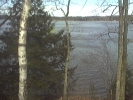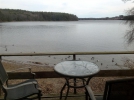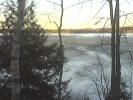The new Minimum Flows Recommendation (see Clary Lake Assessment 3-Apr-13) gives me pause for thought.
First, I’m not quite sure how they came up with this- it appears to be based in large part upon section 6 of Chapter 587, the Standard Allowable Alteration method of determining required water levels in Class GPA (Great Pond Act) waters which however discriminates between a 1′ draw down from April 1st through July 31st and another 1′ draw down (for a total of 2′) between August 1st and March 31st as opposed to a total maximum draw down of 2′.
Second, the document quotes some numbers from the bathymetric survey (the figures 17% of the total lake volume and 14% of the total lake surface area come directly from the data table) but does not arrive at a draw down corresponding to the 25% volume reduction or the 25% area reduction. I’m not complaining, but why? Are they perhaps aware of problems with the modeling of the wetland area?
Third, and I’ve already mentioned this in response to David Hodsdon’s comment on another post, they suggest that the figures they’ve come up with are ONLY intended to protect the main basin of the lake:
Recommended within basin water levels are protective for the maintenance of suitable Water quality, resident fish and Wildlife habitat, and prevention of shoreline erosion. However, it is quite apparent that significant dewatering of valuable Wetland habitat will result in the vicinity of the outlet stream, above the dam.
What’s up with that? One can’t lower the water level in the basin without also lowering the water level in the marsh. How can a 2′ draw down be protective of water quality, resident fish and Wildlife habitat, etc., and yet contribute to “significant dewatering of valuable wetland habitat”?
This sentence is a new addition to the minimum flows recommendation they prepared a year ago.
Fourth and finally, they list minimum outflows which must be met unless inflows are less. How are we supposed to measure inflows? I assume if you’re letting water out and the lake is not falling, then inflows equal outflows. If you’re letting water out and the lake is falling, then outflows are greater than inflows. Finally, if you’re letting water out and the lake is rising, you’re not letting out enough water. This hit-or-miss approach seems amateurish and error prone. Surely there is a better way!
There is: We install a top weir in the dam with stop logs at some level such as 12″ below the top of the dam and walk away and let mother nature take care of it. I wonder what they’ll think of such a plan.
It is also interesting to note that the minimum flow figures are identical to those published a year ago.
Filed under Petition News and Technical Lake Stuff with a hint of Editorial.
 The water level chart update mechanism is broken. I’d hoped to get it fixed over the weekend but I guess I have to write a new script and I really don’t have the time right now. Sorry for the inconvenience. I’ll fix it when I get a chance. In the meantime, if you want to know what the water level of the lake is, go out and take a look!
The water level chart update mechanism is broken. I’d hoped to get it fixed over the weekend but I guess I have to write a new script and I really don’t have the time right now. Sorry for the inconvenience. I’ll fix it when I get a chance. In the meantime, if you want to know what the water level of the lake is, go out and take a look!

 That was quite a stretch of wet weather eh? This afternoon as the sun started to break through I marveled at how long it has been since I’ve seen it, and how much rain we’ve gotten this month. April was a very dry month and May started out just as dry with no rain for the first 8 days. Since then we’ve received 5.5″ of rain which has so far brought the lake up 21.6″ with most of the rise occurring in the last 5 days. This afternoon the lake level sits at 34.9″ right at the bottom of the hole in the dam. As of this afternoon there was no water coming through the hole but as the lake continues to rise over the next few days that will change.
That was quite a stretch of wet weather eh? This afternoon as the sun started to break through I marveled at how long it has been since I’ve seen it, and how much rain we’ve gotten this month. April was a very dry month and May started out just as dry with no rain for the first 8 days. Since then we’ve received 5.5″ of rain which has so far brought the lake up 21.6″ with most of the rise occurring in the last 5 days. This afternoon the lake level sits at 34.9″ right at the bottom of the hole in the dam. As of this afternoon there was no water coming through the hole but as the lake continues to rise over the next few days that will change.
 We’ve finally gotten around to putting current Clary Lake water monitoring data online. It’s a subset of the data collected by David Hodsdon and Jack Holland and will be updated roughly every 2 weeks from early spring through late fall or as often as David and Jack get around to it. What’s online now includes all the data from 2012 and what’s been collected so far in 2013. That little thumbnail at left is what a secchi disk looks like- it’s used to measure the transparency of the water.
We’ve finally gotten around to putting current Clary Lake water monitoring data online. It’s a subset of the data collected by David Hodsdon and Jack Holland and will be updated roughly every 2 weeks from early spring through late fall or as often as David and Jack get around to it. What’s online now includes all the data from 2012 and what’s been collected so far in 2013. That little thumbnail at left is what a secchi disk looks like- it’s used to measure the transparency of the water.





 I have just submitted my comments on the Clary Lake Assessment (minimum flows recommendation) which was one of the two documents included in the ADDENDUM to the bathymetric survey released by the Department on 09 April 2013. I’m not sure my comments are really worthy of a BAM! thumbnail but it seemed appropriate. This is the 3rd submission this week. A short 3-word summary of my position on the new Clary Lake Assessment: Almost Good Enough:
I have just submitted my comments on the Clary Lake Assessment (minimum flows recommendation) which was one of the two documents included in the ADDENDUM to the bathymetric survey released by the Department on 09 April 2013. I’m not sure my comments are really worthy of a BAM! thumbnail but it seemed appropriate. This is the 3rd submission this week. A short 3-word summary of my position on the new Clary Lake Assessment: Almost Good Enough:








